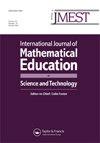两位小学几何数位资源整合之路径
IF 0.6
Q3 EDUCATION & EDUCATIONAL RESEARCH
International Journal of Mathematical Education in Science and Technology
Pub Date : 2023-11-08
DOI:10.1080/0020739x.2023.2268101
引用次数: 0
摘要
摘要本文报告了哥伦比亚小学教师在使用技术工具方面经验丰富,如何将数字资源整合到教学实践中的一些研究结果。具体来说,我们研究了几何教学中这些资源的选择和整合(包括拨款和协调)的过程。我们的目标是说明教师在使用文献教学法选择和整合数字资源时遵循的潜在路径(以及相关标准)。因此,我们提出了一年级教师和五年级教师的案例研究,描述了他们在各自的几何课程中的路径。教师对数字技术资源利用的知识和信念以及学生对这些资源的潜在参与程度影响了教师所采取的途径。在教师选择和编排数字资源时,所有这些方面都会发挥作用。我们的实证数据分析使我们能够推断出资源选择的几个标准,以及教师在将数字资源整合到课堂中时所表现出的编排和挪用水平。这项工作可以为进一步探索教师如何整合数字资源提供宝贵的见解,并有助于制定专业发展计划。关键词:教师实践、小学几何、数字资源、选择、拨款、编曲、文献教学法致谢作者感谢Luc Trouche教授在编写本文初版时的帮助。我们也承认,在向当局、家长和参与者进行书面和口头陈述后,本文中介绍的研究在伦理上得到了开展研究的哥伦比亚学校的批准。该研究项目还得到了墨西哥研究与高等研究中心(Cinvestav)数学教育系的批准。此外,我们研究中的所有研究参与者都提供了他们的知情同意书,尽管本文中给出的名字是假名。该研究的部分资金由墨西哥国家研究与技术委员会(CONACYT)通过Becario #678019赠款提供。披露声明作者未报告潜在的利益冲突。本研究得到了墨西哥国家科学技术委员会(Conacyt)的资助:[批准号Becario 678019]。本文章由计算机程序翻译,如有差异,请以英文原文为准。
Paths of integration of digital resources for geometry by two primary-school teachers
AbstractThis paper reports some results of a study on how Colombian primary-school teachers, experienced in the use of technological tools, integrate digital resources into their practice. Specifically, we investigate the processes of selection and integration (including appropriation and orchestration) of these resources in the teaching of geometry. We aim to illustrate the potential paths (along with associated criteria) that teachers follow when selecting and integrating digital resources into their practice, using the Documentational Approach to Didactics. Accordingly, we present case studies of a 1st-grade teacher and a 5th-grade teacher, which describe their paths during their respective geometry lessons. The paths followed by the teachers were influenced by their knowledge and beliefs regarding the utilisation of digital technology resources and the potential student engagement with such resources. All these aspects come into play as teachers select and orchestrate digital resources. Our empirical data analysis enabled us to infer several criteria for resource selection and levels of orchestration and appropriation manifested by the teachers as they integrated digital resources into their classes. This work can provide valuable insights for further exploration of how teachers integrate digital resources, and can contribute to the development of professional development programmes.Keywords: Teachers’ practicesprimary-schoolgeometrydigital resourcesselectionappropriationorchestrationDocumentational Approach to Didactics AcknowledgmentsThe authors thank Prof. Luc Trouche for his help in preparing the initial version of this document.We also acknowledge that the research presented in this paper was ethically approved by the Colombian schools where it took place, after written and oral presentations to the authorities, parents and participants. The research project was also approved by the Department of Mathematics Education of the Centre for Research and Advanced Studies (Cinvestav), Mexico. Additionally, all research participants in our study provided their informed signed consent, although the names given in this paper are pseudonyms.Partial funding for the research study was provided by Mexico’s National Council for Research and Technology (CONACYT), through the Becario #678019 grant.Disclosure statementNo potential conflict of interest was reported by the authors.Additional informationFundingThis work was supported by Mexico's Consejo Nacional de Ciencia y Tecnologia (Conacyt): [Grant Number Becario 678019].
求助全文
通过发布文献求助,成功后即可免费获取论文全文。
去求助
来源期刊

International Journal of Mathematical Education in Science and Technology
EDUCATION & EDUCATIONAL RESEARCH-
CiteScore
3.30
自引率
11.10%
发文量
123
期刊介绍:
Mathematics is pervading every study and technique in our modern world, bringing ever more sharply into focus the responsibilities laid upon those whose task it is to teach it. Most prominent among these is the difficulty of presenting an interdisciplinary approach so that one professional group may benefit from the experience of others. The International Journal of Mathematical Education in Science and Technology provides a medium by which a wide range of experience in mathematical education can be presented, assimilated and eventually adapted to everyday needs in schools, colleges, polytechnics, universities, industry and commerce. Contributions will be welcomed from lecturers, teachers and users of mathematics at all levels on the contents of syllabuses and methods of presentation.
 求助内容:
求助内容: 应助结果提醒方式:
应助结果提醒方式:


